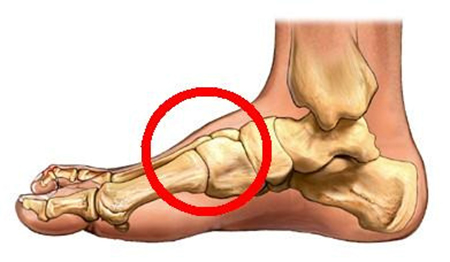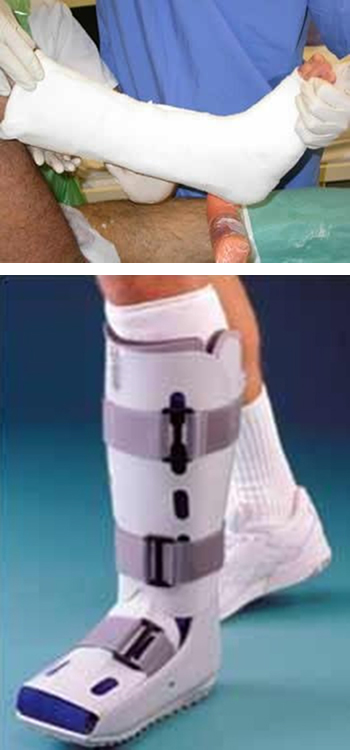 This is an operation to “fuse” or stiffen one or more of the small joints in the middle of the foot (the “tarsometatarsal” joints). Tarsometatarsal fusions are done for two main reasons:
This is an operation to “fuse” or stiffen one or more of the small joints in the middle of the foot (the “tarsometatarsal” joints). Tarsometatarsal fusions are done for two main reasons:
We often inject local anaesthetic or steroid into damaged joints, before any surgery is considered, to see whether this helps the pain. In some people, this gets rid of the pain and surgery is not necessary. In others, pain relief does not last but the results of the injection helps us to decide which joints to fuse.
THE SURGERY
One or more cuts about 3-4 cm long are made on the upper or inner surface of the foot. Each joint which is to be fused is opened up and the joint surfaces removed and, if necessary, reshaped to correct a deformity. The joints are then put in the correct place and fixed together with screws and plates.
It is usually necessary to put some extra bone into a tarsometatarsal fusion to get it to heal and to fill any gaps in the fusion left by correcting deformity. Usually this extra bone has to be taken from the shin just below the knee. The skin is then closed with stitches.
Some people with deformities of the foot also have deformed toes. Again, these be corrected at the same time or at a later operation.
HOW LONG WOULD I BE IN HOSPITAL?Most people can come into hospital on the day of surgery. After surgery your foot will tend to swell up quite a lot, especially if you have had extra surgery such as a tendon transfer or toe straightening procedure. You will therefore have to rest with your foot raised to help the swelling to go down. This may just need to be overnight, or it may take 2-3 days. If you get up too quickly this may cause problems with the healing of your foot. Once the swelling goes down and the cut on your foot is healing your foot you can get up with crutches and go home. The physiotherapist will teach you how to walk with crutches. We will get you up as soon as possible! Most people are in hospital for 1-2 days. |
WILL I HAVE TO GO TO SLEEP (GENERAL ANAESTHETIC)?The operation is usually done under general anaesthetic (asleep). Alternatively, an injection in the back, leg or around the ankle can be done to make the foot numb while the patient remains awake. Your anaesthetist will advise you about the best choice of anaesthetic for you. In addition, local anaesthetic may be injected into your leg or foot while you are asleep to reduce the pain after the operation even if you go to sleep for the surgery. You will also be given pain-killing tablets as required. |
 FOLLOWING YOUR SURGERY
FOLLOWING YOUR SURGERY
-
ON THE WARD
A plaster splint down the back of your ankle and under your foot will be applied while you are asleep. This is only a half-plaster, to allow for swelling.
You will be provided with crutches when you are discharged from hospital, and a physiotherapist will teach you how to use these.
You cannot put any weight through your plaster in the first two weeks.
You can usually take some weight for balance once the wounds are healing well and the swelling is going down – usually about 10-14 days.
It is very important that the leg remains elevated most of the time in the first 2 weeks. Do not wet or remove the plaster.
-
WHEN YOU GO HOME
It is normal to expect:
-
SWELLING – this can be minimised by elevating your foot above your heart
-
PAIN – You will receive a prescription for pain medication on discharge from hospital. Pain can also be minimised by elevating your leg.
-
BLEEDING – This always occurs. You may notice some oozing through the bandages.
You will need to wear a plaster or brace from your knee to your toes until the bones have fused – usually 8 weeks.
Further appointments10-14 days after your operation you will be seen again – your plaster will be removed and the cuts and swelling on your foot checked. Your foot is then put into a fracture boot (moon boot). Crutches will still be required. No weight should be put through the leg. About two months after your operation you will come back for an x- ray. If this shows that the joints are healed enough to take your weight, you can start walking in the moon boot. This is slowly weaned in the coming weaks. You may have further x-rays over the next few weeks: exactly when and how often will be determined by how well your foot is healing. |
HOW SOON CAN I….
-
WALK ON THE FOOT?
As explained above, you should not walk on the foot for at least six weeks after surgery.
-
GO BACK TO WORK?
If your foot is comfortable, and you can keep your foot up and work with your foot in a special shoe, you can go back to work within 2-3 weeks of surgery. On the other hand, in a manual job with a lot of dirt or dust around and a lot of pressure on your foot, you may need to take anything up to six months off work. How long you are off will depend on where your job fits between these two extremes.
-
DRIVE?
If you have only your left foot operated on and have an automatic car you can drive within a few weeks of the operation, when your foot is comfortable enough and you can bear weight through it. Most people prefer to wait till the plaster is removed and they can wear a shoe.
-
PLAY SPORT?
After your plaster is removed you can start taking increasing exercise. Start with walking or cycling, building up to more vigorous exercise as comfort and flexibility permit. Obviously, the foot will be stiffer after surgery and you may not be able to do all you could before. However, many people find that because the foot is more comfortable than before surgery they can do more than they could before the operation. Most people can walk a reasonable distance on the flat, slopes and stairs, drive and cycle. Walking on rough ground is difficult after a tarsometatarsal fusion because the foot is stiffer. Most people cannot play vigorous sports such as squash or football after a tarsometatarsal fusion.
IF YOU ARE CONCERNED:
|
